Water-Well Development
After visiting Ethiopia as a result of the famine in 1984, Food For Children became involved in the creation of water wells. Along with nutritious food and basic medicines, clean water is a very important resource for improved health. In collaboration with the Medical Mission Sisters, Food For Children provided funds for the creation of some water wells. Quoting from a report issued by the Medical Mission Sisters, after completion, "there have been marked decreases in morbidity and mortality from vomiting and diarrhea with the increase in the number of safe water sites." There will always be a need for additional water wells, and funds are needed to maintain the existing sites.
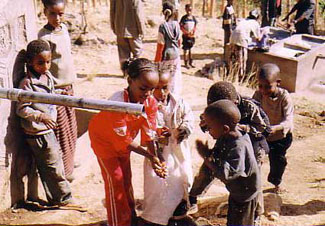
Young children (pictured) enjoy safe water. Read below for complete story and images of the long process involved in this project.
Water Project in Ethiopia
Folks in the Coronation and Brownfield communities know how important water is. And they are also extremely generous. So it is no surprise that the community responded with amazing speed and generosity to the request of Willa and Cliff Suntjens for help with a water project in Ethiopia. It was our privilege to travel to Ethiopia in early December and have returned with the following update on the water project.
Experienced development aid workers know that you don’t simply go to any community and drill a well or repair a spring and expect that it will still be in good repair in a few years time. They know through long experience that the only way to make a project of this kind work for the long haul is to start with the grass roots community and get them to “own” the project from the very beginning. Fortunately, Cliff and Willa work with some amazing and experienced people when it comes to water development. The hospital administrator Sister Elaine has had a passion for water projects in Africa (along with medical work and a host of other initiatives) for thirty years. As well, their Outreach development worker, Endele, is a veteran of many successful projects in the four years he has worked with St. Lukes. So well before we had arrived, they had selected a community that needed a water project that was also ready to take responsibility for the project as a community.
One unique aspect of this particular community is that there are both Muslims and Orthodox Christians living closely together, and they have been sharing the same spring for as long as anyone could remember. The spring has been running for at least the last 140 years according to the elders in the community. The spring itself is on Muslim land but for a long time, the Christians have considered it holy water because several people had been healed of ailments through its use. They also use the spring water for their supply of water used in worship at the church. All of this had been accepted as a matter of course, but as the idea of developing the spring came forward, these facts became significant as the community grappled with this new development. Prior to our coming, Endele and others had met with the community on two occasions to try and get the project going.
Happily for us, a trip to the community was planned during our stay with Cliff and Willa. So we went to the village with Cliff and Endele and a driver to a meeting of the elders. At the previous meeting, Endele had wisely asked the community to select 7 elders to represent the Muslims and 7 for the Christians. He told us that if we could not come to an understanding on the project this time, a new community would have to be chosen. We packed up in the morning and stopped at a bakery in town to buy some bread as a gift from donor community for the meeting and off we went. The ride itself was an adventure and we certainly know why a 4wheel drive is standard gear for development workers!
We met at the village and the meeting began. Our driver was translating for the Canadians and we all sat in a circle. Faye asked Endele to bring greetings from our community and passed around a few pages of pictures of school children from our area. It was fun to see the elders look at each page of pictures. They got a good chuckle when Faye asked Endele to make it clear that those were not all her children. Through the translator one old Muslim man said they knew about family planning – but he had ten children and was quite proud of that. He thought Faye’s three was a skimpy number.
The meeting soon started to get tense. Even without translation you could tell that there were some strong opinions. Endele decided to split the group up. He went and met with the Muslim elders while we waited with the Christians who talked among themselves. At a couple points Endele had to be quite firm with groups of younger men who kept wanting to join the discussions. Endele held firmly to the agreement from the previous meeting that 7 members from each group were enough. He sent the young men on their way with a flourish of language that seemed pretty colorful.
When Endele returned with the Muslims he told us that they could not reach an agreement. He then said to the whole group that because agreement was not forthcoming after three meetings, he must move on to another community. He then remembered that we had brought bread for the meeting, so it was decided that we could at least eat before we parted. Quickly some women showed up with coffee and roasted grains and beans to add to the bread and everyone sat down to eat.
Quietly at first, it became apparent that the men were again talking to one another. Through our translator we learned that the older men wanted an agreement and knew that they really needed the spring protected but that the younger men were entrenched in their positions of whose land it was and whose holy water it was. As the meal drew to an end, Endele suddenly stood up and said that there was a tentative agreement and that we would go down to the spring and try to settle the specifics. With that the whole group walked the 500 yards to the area of this much talked about spring. As you can see in the picture at the time of year we visited the spring was pretty much an oozing green slimy pound that issued a small stream of water down the parched hillside.
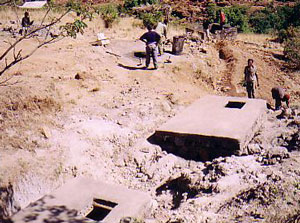
After twenty minutes in the sun, a compromise was agreed upon. The spring would be developed and the large holding cistern would be divided into two segments. One segment would be used for regular community use and a small section for holy water. The holy water would be piped from the cistern for 200 feet to Christian land for use in the church. The Christians would pay for this added expense. Soon all 14 elders were happily discussing the best way to get the truck bringing the community supplied sand and gravel into the site, and how they would provide food for the masons and spring development workers. It was agreed that the sand and gravel would be sourced in three days time on Friday and work would commence on Monday.
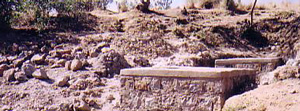
It’s important to choose the best water project for the situation. When there is a good quality and reliable spring, it is the cheapest and best to develop with a spring protection development where the spring is sealed off and the water filtered through sand and gravel and piped from behind a cement barrier to a large holding cistern several hundred feet away. Separate outlets are provided for potable water, clothes washing, showering and cattle watering. These are all separated from each other and fenced to keep animals out. Where no spring is available the next choice is a hand dug well. If not a bored well is chosen but that is the most expensive. When a well is dug or spring is developed, the community must supply about 30% of the cost of the project by supplying sand, gravel and rocks as well as food and housing for the workers. The donors supply the cement, the knowledge and the wages for the masons. The development officer also trains the community on how to manage the water supply and keep it in good repair and keeps going back of the next months and years until it is clear that the people are well on top of managing the water supply.
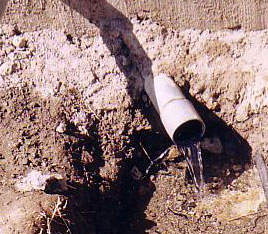
We left Ethiopia on Sunday, wondering somewhat if Endele’s agreement would hold. The last word we heard from Endele was that true to their word the men had bought and trucked the materials to the sight and that everything was proceeding. They sent a delegation all the way to the place the sand was sourced to insure that the quality, price and terms were fair. On arrival at home, we received an email from Willa that included news and pictures from the project. The spring actually has two eyes, and both were being protected and good progress made.
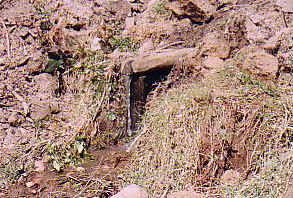
Walking up from the spring that day we teased Endele, that after such diplomacy they might need him at the UN to help negotiate with Iran and Mr. Bush. He indeed had done good work. The elders knew they needed the spring, but were stuck with long held traditions and the hardened positions of the younger men. His patience and understanding of their concerns helped them sort things out, and his willingness to walk away helped them get past their differences to their common opportunity. Faye noted wryly to Cliff that once the water was coming out clearly from a spigot with no bacterial contamination that both Muslims and Christians would likely find it holier than ever before.

We were pleased to represent our community as we gave tangible aid to another community. It is always more complex than you think at first, but also more gratifying, knowing as we do that the money will meet a real need, that the community truly “owns” the project and that likely the spring will be serving fresh clean and truly holy water to a community, perhaps as long as a hundred and forty years from now.
Water Well Development in Dere Dulety
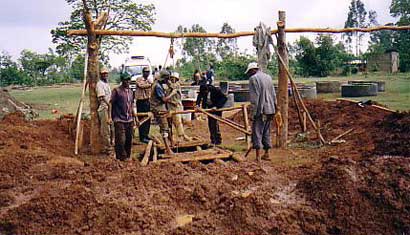
These images show the beginnings of well digging in Dere Dulety. In the first photo you can see the well site with the dirt dug from the well. In the background are the rings to line the well.
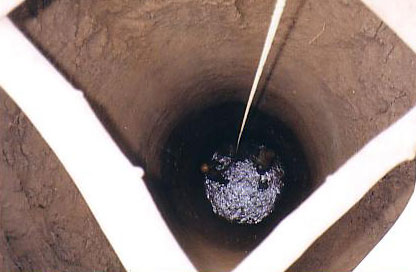
The second picture shows the men down in the well digging. The white lines are the pieces of wood on the surface of the well.
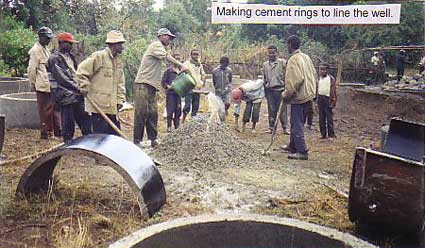
This picture shows the men mixing the stones, sand and cement to make the rings for the well. A few pieces of the molds for the rings can be seen as well. The inside of the molds are painted with oil to make it easier to take off the mold once the ring is formed.
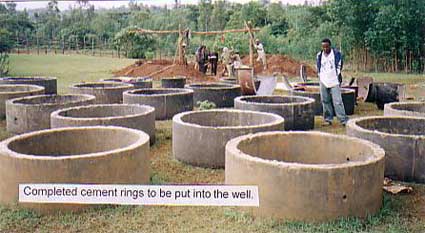
This picture shows the rings ready to be put into the well.
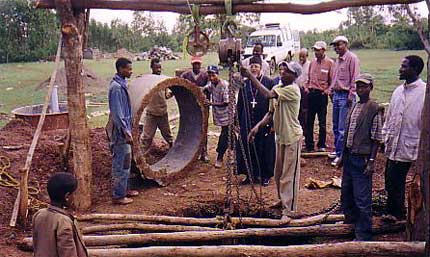
The last photo shows one of the rings getting ready to be put into the well. The Archbishop was there the day this was done.
Water Well Development in Upper Gelisa Cheka
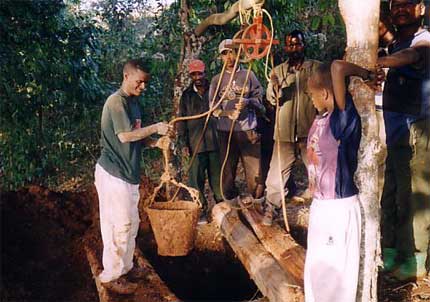
Here are some photos of the hand dug well in Upper Gelisa Cheka - the one that was successful! The first well we dug for them was dry. So we went a bit down the hill and SUCCESS.
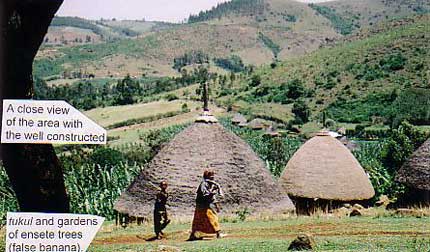
Upper Gelisa Cheka is a very beautiful highland area. The people have a few springs but they were in poor locations for protecting and had very small yields. There were some local wells in the area, so after visiting and talking with them we have started the well.
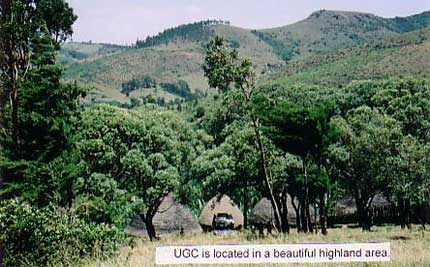
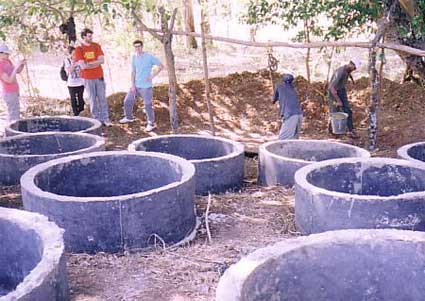
Your $1,000.00 will be a big help as this well should not cost too much. Hopefully we will be able to get sufficient yield for a hand pump.
The first picture shows the team from the hospital meeting with the community and community leaders. The well site will be in this place as well. The next two photos show the area with the beautiful and well constructed tukuls and some of the indigenous trees.
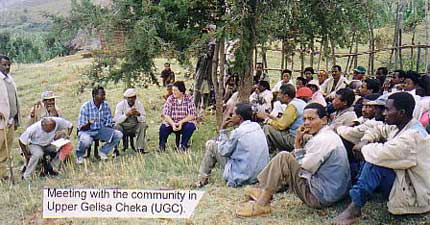
The people are very friendly and hospitable. One of the leaders is a business man from Addis who is originally from the area. He is sitting next to me on my right.
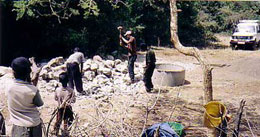
The last picture shows a bit of the work of making the rings. Here one of the men is breaking the stones to make the rings. This is all done by hand and not by a machine! This picture was taken at another well site in Gelisa Cheka.

